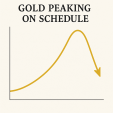Fed Huffing And Puffing
Over the past few weeks a number of Fed officials, including Fed Chair Janet Yellen, have mused about an interest rate hike at the September FOMC that takes place next week, on September 20-21, 2016. The interest rate decision comes out around 2 pm EST on September 21. It will be a much-watched announcement. Stocks, bonds and precious metals markets all reacted negatively to the musings when the fourth Fed official (including Yellen) since August 2016 talked about a rate hike. Despite labour numbers that appear to point to decent economic growth and an inflation rate (PCE Inflation) that hovers below the Fed’s target of 2%, the overall picture is not one of economic strength, with many indicators and numbers actually pointing down.
By some calculations, the US has already entered a recession. But there appears to be a strong desire, at least by some Fed members, to hike interest rates to bring what they call normalcy to the markets. Nobody else, of course, is hiking interest rates. Not the EU nor Japan, where both economies remain weak. There is less than two months to go before the election as well, an election that has become increasingly controversial and volatile. So for many, the expectation is that the Fed is trapped, that they can’t hike rates next week. Even Goldman Sachs has lowered the odds of a Fed hike. Moreover, the Fed Funds Rate is not exactly pricing in a hike. But given all of the musing of a hike, will the Fed’s credibility be on the line if they don’t hike rates? Or is this really a lot of huffing and puffing, sowing discord and some volatility into markets in order to keep things in check? The decision comes next Wednesday at 2pm EST.
Weekly Market Review
Stocks
Global stock markets broke down this past week, following comments from a Fed official (the fourth) musing about an interest rate hike at the September FOMC. Numerous short-term trends turned down as a result. Support zones were broken. Volatility increased sharply. All markets broke, at least initially. Along with stocks, the bond market fell in price (as yields move inversely to bond prices) - and precious metals (gold and silver) also fell. We take a look at the relationship between bonds and stocks over the years. The two are roughly correlated, although there are periods where yields rise but stocks don’t fall, and vice versa.
Bonds
Bond yields rose around the world this past week (prices fell, as prices move inversely to yields), as markets reacted to the thought of a Fed interest-rate hike. We discuss how low interest-rate yields are killing savers, pension funds and insurance companies. Globally, pension funds have become hugely underfunded. This threatens retirees, as there may be insufficient funds available to pay them the pension that many are expecting. To compensate, many investors have moved into riskier assets, including junk bonds. But junk bonds are high risk for default if the economy should turn down or interest rates rise sharply. Bond yields have been so low for such a long time that even a small upward move could prove to be devastating for many. With global economies remaining anaemic at best, the jump in interest rates is coming as a surprise for many.
Currencies
The talk of a Fed hike helped push the US$ Index slightly higher this past week, but overall its rise was muted. The euro, which constitutes 57.6% of the US$ Index, was actually up slightly on the week. The ongoing strength of the euro has been surprising, and this is suggesting to us that the next move for the US$ Index may actually be down rather than up, as many are saying. For 18 months now, the US$ Index has been caught in an ever-narrowing pattern that could be interpreted as either a top or a consolidation pattern. The latter would break to the upside, suggesting new highs for the US$ Index, while the former would break to the downside. The euro shows the opposite pattern. We also take a look at the Cdn$ and its long relationship with WTI oil. Despite a drop in the Cdn$ and WTI oil this past week, both are potentially forming an interesting head-and-shoulders bottom pattern. Naturally there are points to the downside we would not want to see taken out.
Gold And Other Precious Metals
The musing by Fed officials helped push gold and silver prices lower this past week. The gold stocks also fell, and the gold miners sentiment index is now at levels where some earlier bottoms were seen (but well off the extreme negative sentiment seen at the lows in 2015). The recent consolidation of gold and silver is increasingly taking on a potential bullish look for us. We look once again at the support/resistance levels that need to be watched carefully. Gold is currently approaching key support zones, but silver is holding up a potential positive divergence. A potential negative is the commercial COT that was down again this pas week. But one thing we view positively is the gold/silver ratio that has been increasingly moving favourably for silver. We take a look at some history of the gold/silver ratio, and note how recent highs put gold in overvalued territory vs. silver. The uptrend line that had been in place since 2011 has recently broken down in silver’s favour, and this could bode well for silver going forward. As well, since silver tends to outperform in both up and down markets, the fact that silver is now outperforming gold as prices move higher is positive for a bull market in gold and silver.
********
David Chapman is Chief Economist with Bullion Management Group Inc. He regularly writes articles of interest to the investing public. David has over 40 years of experience as an authority on finance and investment, through his range of work experience and in-depth market knowledge. For more information on Bullion Management Group Inc., BMG BullionFund, BMG Gold BullionFund and BMG BullionBarsTM, visit www.bmgbullion.com, email [email protected], or call 1 888.474.1001.
© 2016 Copyright David Chapman - All Rights Reserved
Disclaimer: The above is a matter of opinion provided for general information purposes only and is not intended as investment advice. Information and analysis above are derived from sources and utilising methods believed to be reliable, but we cannot accept responsibility for any losses you may incur as a result of this analysis. Individuals should consult with their personal financial advisors.


















